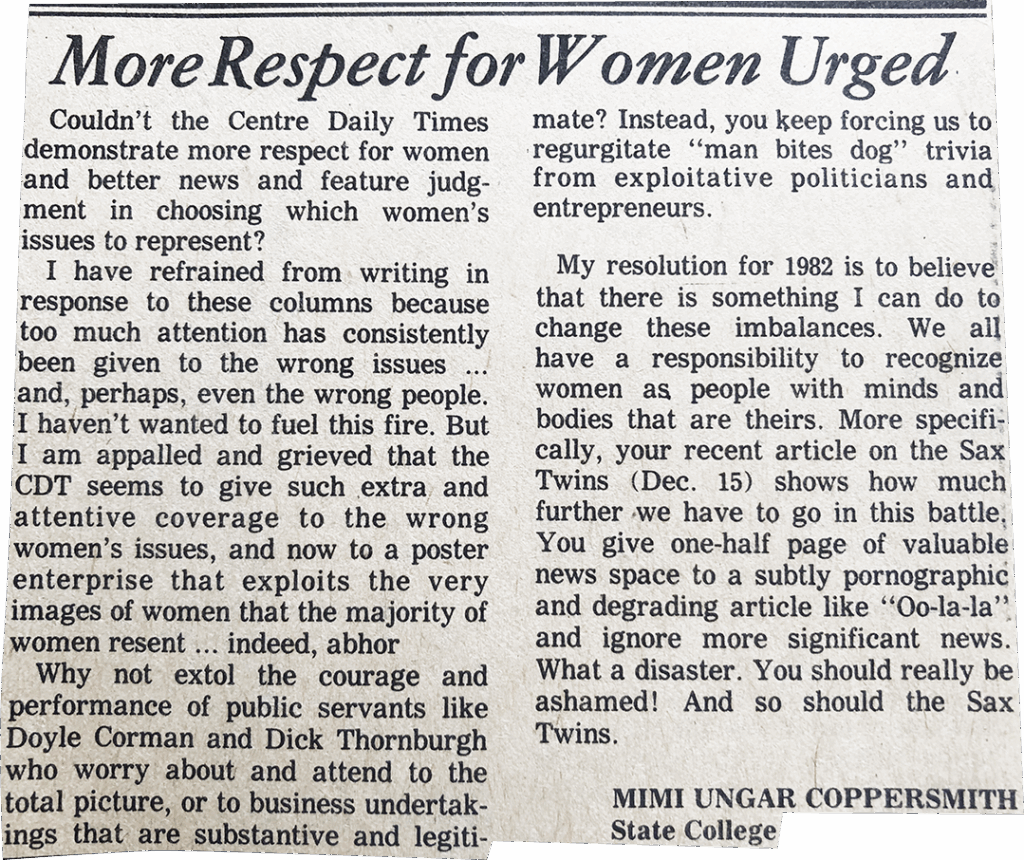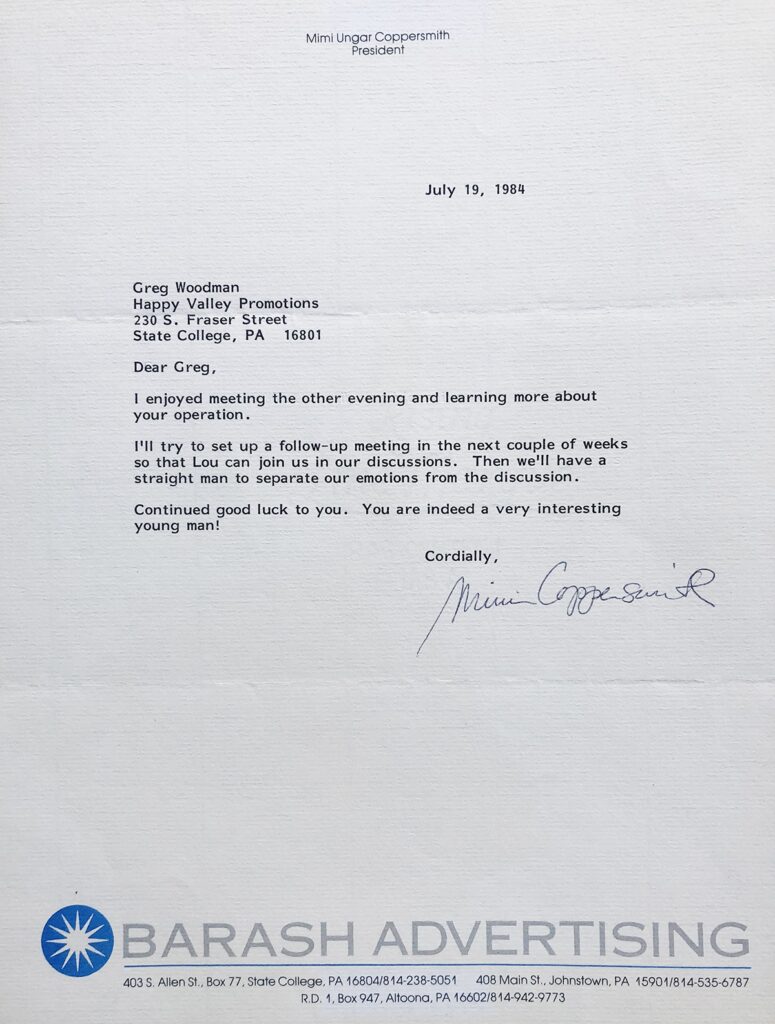By Greg Woodman
Most of us are happy to be in the parade. Or content to watch the parade. We enjoy the music, the fellowship, the energy of marching together. But very few want to step out front, where the spotlight shines, where the risks are highest, and where the critics are loudest. Mimi Barash Coppersmith never hesitated. She lived her life out front of the parade, calling others to follow, closing the gap between idea and action with a simple rallying cry: “Let’s do it.”
Her Fingerprints Everywhere
Mimi believed her name belonged on the marquee, and she was relentless about it. She co-founded Town & Gown magazine in 1966 and shepherded it for nearly five decades. Even after selling the publication in 2008, she made sure the masthead continued to list her as Founder. It was a reminder to every reader, advertiser, and future publisher that the parade they were in had started with her.
Her presence was felt across Happy Valley. She was president of the State College Chamber of Commerce, where she helped spark Penn State’s takeover and expansion of the University Park Airport. She co-founded and later chaired the Central Pennsylvania Festival of the Arts, which remains one of the region’s signature events. She coordinated capital campaigns for Centre LifeLink EMS, helped steer the Palmer Museum of Art, and guided the State College Choral Society’s Holocaust Memorial Project.
Her philanthropy was just as visible. She threw her energy behind the American Cancer Society, Pink Zone, Girl Scouts, Centre Safe, Youth Service Bureau, Jana Marie Foundation, Strawberry Fields, Discovery Space and the Centre County Historical Society. She put her name on scholarships at Penn State and championed and mentored women in leadership long before it was fashionable.
And she never shied away from controversy. Her early Town & Gown “Catalyst” column denounced the Elks Club’s discriminatory membership practices, costing her advertisers. In 1973, her “Joe, Don’t Go Pro” campaign mobilized the community to convince Joe Paterno not to leave Penn State for the Patriots. Later, as the first woman to chair Penn State’s Board of Trustees, she pushed the university to divest from South African investments and to adopt its first LGBTQ rights policy.
If her name was on it, she owned it, whether it brought applause or dissent.
A Century of Excellence and a Kindred Spirit
Mimi had a way of shaping careers, often without you realizing it at the time. She certainly shaped mine. My first product as a college student through Happy Valley Promotions, a poster featuring twins on the Nittany Lion, caught her attention in 1982. In a letter to the Centre Daily Times, she blasted the coverage as “appalling,” “a disaster,” even “pornographic.” She said the paper should be “ashamed,” and so should the twins. It was classic Mimi: bold, uncompromising, and willing to stir controversy when the moment demanded it.

A few years later, she reached out directly. In a letter on Barash Advertising letterhead, she encouraged me to keep going, even while noting from our first in person meeting that both of us were emotional and needed Lou Coppersmith’s steadying presence in the mix. Emotion was our kindred spirit. For me, balancing heart and fear has always been a work in progress. I am not as tough as Mimi was, and I doubt I ever will be. I have not had the courage to lead in her style, yet I deeply respect it.

By 1986, when she hired me to work on the Century of Excellence magazine, Mimi was more than a community leader. To me, she became a model of what it looked like to be both tough and protective, demanding and loyal. She challenged me, defended me, and in doing so, left an imprint that continues to shape the way I think about and teach leadership.
She also had a way of making business personal. We often went to dinner at the Eutaw House, (closed in 2009) out of town in Potters Mills. To this day I was never sure why she chose a restaurant so far away. Was it because she did not want to be seen with me, or because she wanted to show off her empire? On the way out and back she spoke to every billboard she owned, rattling off how much revenue each one brought in monthly. It was part charm, part theater, and part hard-nosed business. She blended toughness with warmth, debate with storytelling, and vulnerability with courage. Everything about her, from publishing to advertising to fundraising, carried the same spark: visible, emotional, and entirely hers.
Her Why
Mimi explained her drive in her own words:
- “It is more fun to do for others than for yourself.”
- “I am a woman of action, and almost nothing stands in my way when I’m intent to conquer something, even in myself.”
- “The great work you do fades quickly… don’t rest on your laurels. Keep thinking about your next big idea.”
- “I want to be remembered as a fair person, as a kind person, as a person who didn’t hesitate to express her point of view … as someone who, if you want to get a job done, ask Mimi.”
Her why was not complicated: to connect, to build, to serve, to act. She taught us that love and logic are not opposites in leadership. They are partners.
Who Leads the Parade Now?
Mimi is gone now. She passed away in September at the age of 92. With her passing comes an unavoidable question. Who steps out front today? Who carries the banner when our community needs to accelerate, to be bold, to take risks that make the rest of us uncomfortable? Who is out there willing to put their name, their reputation, their heart on the line to make something new and cool happen?
Mimi showed us what that looks like. She proved that progress requires visibility, courage, persistence, and a willingness to say yes when everyone else hesitates. Her challenge to us is not just to remember her, but to ask ourselves: are we content to march in the parade, content to watch the parade, or are we ready to lead it?


One Response
It’s vey clear to me who steps out front (he already has)!!